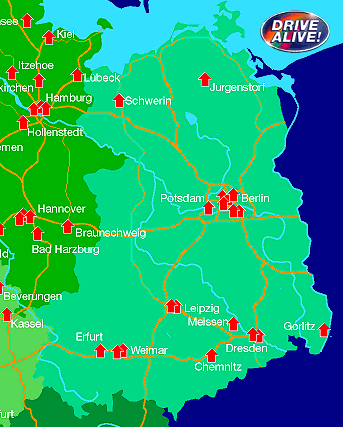
East Germany is now emerging from the austerity of its isolation during
the Cold War and revealing its many treasures as a tourist region. As well as some
superb castles and palaces set amongst spectacular scenery, the great cities of
Berlin, Leipzig and Dresden are complemented by numerous beautifully preserved medieval
towns. The scenery varies from the holiday resorts and flat plains in the north
through the lovely central lakes to the almost chocolate box beauty of the Harz
mountains and the wilder grandeur of the Zittau range in the south.
The north of eastern Germany borders the Baltic Sea and is a very popular summer
holiday destination, as is the large island of Rugen. The town of Wismar
makes a good base to explore the coast and has a beautiful medieval centre. The
main seaside resorts - Bad Doberan, Heiligendamm and Kuhlungsborn
- are linked by a scenic narrow gauge railway. Eastwards from the ferry port of
Rostock the coast becomes more rugged, and sand dunes abound. Stay in lovely
Straslund and take a day-trip or longer to popular Rugen, an island with
beautiful sandy beaches, forests, imposing chalk cliffs, rolling hills and woods.
The holiday island of Usedom has some excellent beaches.
In the west of the northern province of Mecklenburg is the ancient city of
Schwerin, beautifully situated among ten lakes. From here, explore the Mecklenburg
Lake District, a lovely and largely undiscovered area of rolling farmland amongst
650 lakes, teeming with wildlife.
Map of East Germany
Berlin is one of the essential tourist destinations of the world. There's
something for everyone; historic monuments, stunning architecture, major museums
and galleries, concert halls and venues galore, lovely parks, sophisticated shops,
wonderful restaurants, excellent bars, a famously lively nightlife. Add to this
its recent history as a divided city and its symbolic importance as the place where
the Wall fell, and Berlin is truly a city worth travelling to. Arm yourself with
a good guide and enjoy yourself. If you've got the time visit the nearby town
of Potsdam, with its superb formal gardens and palaces. 50 kms further west
is Brandenburg, enjoying a lovely position on three islands and boasting
some fine old buildings. The countryside for 100 or so kms to the north and south
east of Berlin is a beautiful land of lake-strewn forests, and is an added bonus
when you visit this part of Germany.
In the province of Saxony-Anhalt, Magdeburg has one of the finest churches
in Germany, as well as other worthwhile sights. The church at Havelberg,
an inland fishing port, contains a stunning choir screen, and the crooked streets
of the old town give glimpses of the riverfront. Be sure to visit Wittenberg
and its famous university where Martin Luther lectured. See the beautiful parkland,
palace and lakes at Worlitz. Dessau's fame is as the birthplace
of Bauhaus architecture, and many examples are scattered throughout the town. The
main tourist draw in the province is the Harz mountains in the south-west,
a beautiful region of wooded slopes, verdant valleys and spectacularly well-preserved
old towns such as Halberstatdt, Quedlinburg, Blankenberg,
Wernigerode and Stolberg. The whole area is served by narrow gauge
railways, and is superb for walking amid stunning scenery, and in the winter you
can try the skiing.
The province of Thuringia is largely forested, and the Thuringian Forest
in the south-west offers some of the finest walking in Germany. Stay in either
Friedrichroda or Schmalkalden and take the numerous marked trails
for all levels, but none too strenuous. The main city of Thuringia, Weimar,
is famous for the role it has played as a centre of artistic and cultural excellence,
and is particularly associated with Schiller and Goethe. A sad reminder of the Nazi
past is the concentration camp at Buchenwald, outside the town. In the north-west
of the province are the Kyffhauser mountains, largely uninhabited but with
excellent and numerous marked trails. Stay at the small spa town of Bad Frankenhausen.
Leipzig is perhaps the livliest city in Saxony and a famous cultural
centre. To the south is the town of Colditz of war-time fame, and the pretty
valley which leads to Zwickau via the picturesque towns of Rochlitz,
Wechselburg and Rochsburg. Zwickau itself retains an interesting medieval
centre. Dresden, although horribly bombed in the last war, has enough left
of its former glory to make it well worth visiting, especially the Zwinger Palace,
the Semperbau (with its galleries of old masters equal to the world's best),
the Hofkirche, the Albertinum and, on the outskirts the twin palaces of Schloss
Pillnitz. 25 kms north-west is Meissen, home of Dresden china, with an impressive
castle and church. South of Dresden is Saxon Switzerland, where the Elbe cuts its
way through dense woods and rocky crags - excellent walking country centred on
Bad Schandau. The Zittau mountains in the east are wild, wooded and
rocky.

 Drive-Alive on Facebook
Drive-Alive on Facebook